Assessing the Impact of the 2004 Indian Ocean Tsunami on South Andaman’s Coastal Shoreline: A Geospatial Analysis of Erosion and Accretion Patterns
Abstract
:1. Introduction
2. Materials and Methods
2.1. Coastal Erosion Mapping Using DSAS Tool
2.2. Validation of Coastal Shoreline of Landsat-7 and Google Earth Images
3. Results
3.1. Analysis of Coastal Erosion Pre- and Post-Tsunami
3.2. Periodical Coastal Erosion
4. Discussion
5. Conclusions
Author Contributions
Funding
Institutional Review Board Statement
Informed Consent Statement
Data Availability Statement
Acknowledgments
Conflicts of Interest
References
- Available online: https://www.noaa.gov/education/resource-collections/ocean-coasts/tsunamis (accessed on 10 March 2023).
- Devi, E.U.; Shenoi, S.S.C. Tsunami and the effects on coastal morphology and ecosystems: A report. Proc. Indian Natl. Sci. Acad. 2012, 78, 513–521. [Google Scholar]
- Britannica, T. Editors of Encyclopaedia. Indian Ocean Tsunami of 2004. Encyclopedia Britannica. Available online: https://www.britannica.com/event/Indian-Ocean-tsunami-of-2004 (accessed on 28 March 2023).
- Praveen, S.S.; Reshmi, A.K.; Dhanya, P.; Kalarani, S.A.; Kurian, N.P.; Murthy, M.R.; Hameed, T.S.; Prakash, T.N. Numerical simulation of the December 26, 2004, tsunami on the southwest coast and Lakshadweep islands of India. Mar. Geod. 2011, 34, 59–67. [Google Scholar] [CrossRef]
- Usha, T.; Murthy, M.R.; Reddy, N.T.; Murty, T.S. Vulnerability assessment of Car Nicobar to tsunami hazard using numerical model. Sci. Tsunami Hazards 2009, 28, 15. [Google Scholar]
- Debnath, J.; Sahariah, D.; Saikia, A.; Meraj, G.; Nath, N.; Lahon, D.; Annayat, W.; Kumar, P.; Chand, K.; Singh, S.K.; et al. Shifting Sands: Assessing Bankline Shift Using an Automated Approach in the Jia Bharali River, India. Land 2023, 12, 703. [Google Scholar] [CrossRef]
- Mukhopadhyay, A.; Mukherjee, S.; Hazra, S.; Mitra, D. Sea Level Rise and Shoreline Changes: A Geoinformatic Appraisal of Chandipur Coast, Orissa. Int. J. Geol. Earth Environ. Sci. 2011, 1, 9–17. [Google Scholar]
- Salghuna, N.N.; Bharathvaj, S.A. Shoreline Change Analysis for Northern Part of the Coromandel Coast. Aquat. Procedia 2015, 4, 317–324. [Google Scholar] [CrossRef]
- Genz, A.S.; Fletcher, C.H.; Dunn, R.A.; Frazer, L.N.; Rooney, J.J. The predictive accuracy of shoreline change rate methods and alongshore beach variation on Maui, Hawaii. J. Coast. Res. 2007, 23, 87–105. [Google Scholar] [CrossRef]
- Jayakumar, K.; Malarvannan, S. Assessment of shoreline changes over the Northern Tamil Nadu Coast, South India using WebGIS techniques. J. Coast. Conserv. 2016, 20, 477–487. [Google Scholar] [CrossRef]
- Kv, P.; Sriganesh, J.; Annadurai, R. Coastal Structures’ Influence on the North Chennai Shore using Remote Sensing and GIS Techniques. Adv. Res. Public 2015, 2, 3–4. [Google Scholar]
- Mahapatra, M.; Ratheesh, R.; Rajawat, A.S. Shoreline Change Analysis along the Coast of South Gujarat, India, Using Digital Shoreline Analysis System. J. Indian Soc. Remote Sens. 2014, 42, 869–876. [Google Scholar] [CrossRef]
- Abdul Maulud, K.N.; Selamat, S.N.; Mohd, F.A.; Md Noor, N.; Wan Mohd Jaafar, W.S.; Kamarudin, M.K.A.; Ariffin, E.H.; Adnan, N.A.; Ahmad, A. Assessment of Shoreline Changes for the Selangor Coast, Malaysia, Using the Digital Shoreline Analysis System Technique. Urban Sci. 2022, 6, 71. [Google Scholar] [CrossRef]
- Kumar, T.S.; Mahendra, R.S.; Nayak, S.; Radhakrishnan, K.; Sahu, K.C. Coastal vulnerability assessment for Orissa State, East Coast of India. J. Coast. Res. 2010, 26, 523–534. [Google Scholar] [CrossRef]
- Woodruff, J.D.; Irish, J.L.; Camargo, S.J. Coastal flooding by tropical cyclones and sea-level rise. Nature 2013, 504, 44–52. [Google Scholar] [CrossRef] [PubMed]
- Du, Y.; Zhang, Y.; Ling, F.; Wang, Q.; Li, W.; Li, X. Water Bodies’ Mapping from Sentinel-2 Imagery with Modified Normalized Difference Water Index at 10-m Spatial Resolution Produced by Sharpening the SWIR Band. Remote Sens. 2016, 8, 354. [Google Scholar] [CrossRef]
- Ford, M. Shoreline changes interpreted from multi-temporal aerial photographs and high resolution satellite images: Wotje Atoll, Marshall Islands. Remote Sens. Environ. 2013, 135, 130–140. [Google Scholar] [CrossRef]
- Debnath, J.; Sahariah, D.; Lahon, D.; Nath, N.; Chand, K.; Meraj, G.; Kumar, P.; Singh, S.K.; Kanga, S.; Farooq, M. Assessing the impacts of current and future changes of the planforms of river Brahmaputra on its land use-land cover. Geosci. Front. 2023, 14, 101557. [Google Scholar] [CrossRef]
- Tha, T.; Piman, T.; Bhatpuria, D.; Ruangrassamee, P. Assessment of Riverbank Erosion Hotspots along the Mekong River in Cambodia Using Remote Sensing and Hazard Exposure Mapping. Water 2022, 14, 1981. [Google Scholar] [CrossRef]
- Murali, M.; Ali, P.Y.; Narayana, A.C. Geospatial Technologies and Climate Change. Mar. Geod 2014, 38, 26–39. [Google Scholar] [CrossRef]
- Daud, S.; Milow, P.; Zakaria, R.M. Analysis of Shoreline Change Trends and Adaptation of Selangor Coastline, Using Landsat Satellite Data. J. Indian Soc. Remote Sens. 2021, 49, 1869–1878. [Google Scholar] [CrossRef]
- Nassar, K.; Mahmod, W.E.; Fath, H.; Masria, A.; Nadaoka, K.; Negm, A. Shoreline change detection using DSAS technique: Case of North Sinai coast, Egypt. Mar. Georesour. Geotechnol. 2019, 37, 81–95. [Google Scholar] [CrossRef]
- Thieler, E.R.; Himmelstoss, E.A.; Zichichi, J.L.; Ergul, A. Digital Shoreline Analysis System (DSAS) version 4.0— An ArcGIS extension for calculating shoreline change. U.S. Geol. Surv. Open-File Rep. 2008, 1278. Available online: http://woodshole.er.usgs.gov/project-pages/DSAS/ (accessed on 12 April 2023).
- Himmelstoss, E.A.; Henderson, R.E.; Kratzmann, M.G.; Farris, A.S. Digital Shoreline Analysis System (DSAS) Version 5.0 User Guide. U.S. Geol. Surv. Open-File Rep. 2018, 2021–1091, 1–104. [Google Scholar]
- Mageswaran, T.; Sachithanandam, V.; Sridhar, R.; Mahapatra, M.; Purvaja, R.; Ramesh, R. Impact of sea level rise and shoreline changes in the tropical island ecosystem of Andaman and Nicobar region, India. Nat. Hazards 2021, 109, 1717–1741. [Google Scholar] [CrossRef]
- Jayanthi, M.; Thirumurthy, S.; Samynathan, M.; Duraisamy, M.; Muralidhar, M.; Ashokkumar, J.; Vijayan, K.K. Shoreline change and potential sea level rise impacts in a climate hazardous location in southeast coast of India. Environ. Monit. Assess. 2018, 190, 1–14. [Google Scholar] [CrossRef]
- Ahammed, K.K.B.; Pandey, A.C. Shoreline morphology changes along the Eastern Coast of India, Andhra Pradesh by using geospatial technology. J. Coast. Conserv. 2019, 23, 331–353. [Google Scholar] [CrossRef]
- Vidya, R.; Biradar, R.S.; Inamdar, A.B.; Srivastava, S.; Pikle, M. Assessment of shoreline changes of Alibag coast (Maharashtra, India) using remote sensing and GIS. J. Mar. Biol. Assoc. India 2015, 57, 83–89. [Google Scholar] [CrossRef]
- Yunus, A.P.; Dou, J.; Avtar, R.; Narayana, A.C. Shoreline and coastal morphological changes induced by the 2004 indian ocean tsunami in the Katchal Island, Andaman and Nicobar–A study using archived satellite images. Coast. Res. Libr. 2016, 14, 65–77. [Google Scholar] [CrossRef]
- Ratheesh, R.; Rajput, P.; Bhatti, H.; Rajawat, A.S.; Rajak, D.R. Quantification of shoreline changes along the entire Indian coast using Indian Remote Sensing satellite images of 2004–2006 and 2014–2016. Curr. Sci. 2023, 124, 578–584. [Google Scholar] [CrossRef]
- Ankrah, J.; Monteiro, A.; Madureira, H. Shoreline Change and Coastal Erosion in West Africa: A Systematic Review of Research Progress and Policy Recommendation. Geoscience 2023, 13, 59. [Google Scholar] [CrossRef]
- Thomas, G.A.J.; Ravindranath, R.R.S.; Jeyagopal, S.; Yoganandham, S.T. Statistical analysis of shoreline change reveals erosion and baseline are increasing off the northern Tamil Nadu Coasts of India. Environ. Monit. Assess. 2023, 195, 409. [Google Scholar] [CrossRef]
- Singh, S.; Meraj, G.; Kumar, P.; Singh, S.K.; Kanga, S.; Johnson, B.A.; Prajapat, D.K.; Debnath, J.; Sahariah, D. Decoding Chambal River Shoreline Transformations: A Comprehensive Analysis Using Remote Sensing, GIS, and DSAS. Water 2023, 15, 1793. [Google Scholar] [CrossRef]
- Rajendran, C.P.; Rajendran, K.; Anu, R.; Earnest, A.; Machado, T.; Mohan, P.M.; Freymueller, J. Crustal deformation and seismic history associated with the 2004 Indian Ocean earthquake: A perspective from the Andaman-Nicobar Islands. Bull. Seismol. Soc. Am. 2007, 97, S174–S191. [Google Scholar] [CrossRef]
- Pereira, G.F.; Gurugnanam, B.; Goswami, S.; Choudhury, S. Application of Geospatial Techniques to Determine Coastal Erosion and Accretion along the Ramanathapuram Shore, Tamil Nadu, India. J. Geol. Soc. India 2022, 98, 1261–1270. [Google Scholar] [CrossRef]
- Tomar, P.; Singh, S.K.; Kanga, S.; Meraj, G.; Kranjčić, N.; Đurin, B.; Pattanaik, A. GIS-Based Urban Flood Risk Assessment and Management—A Case Study of Delhi National Capital Territory (NCT), India. Sustainability 2021, 13, 12850. [Google Scholar] [CrossRef]
- Kinsela, M.A.; Morris, B.D.; Linklater, M.; Hanslow, D.J. Second-Pass Assessment of Potential Exposure to Shoreline Change in New South Wales, Australia, Using a Sediment Compartments Framework. J. Mar. Sci. Eng. 2017, 5, 61. [Google Scholar] [CrossRef]
- Appeaning Addo, K.; Larbi, L.; Amisigo, B.; Ofori-Danson, P.K. Impacts of Coastal Inundation Due to Climate Change in a CLUSTER of Urban Coastal Communities in Ghana, West Africa. Remote Sens. 2011, 3, 2029–2050. [Google Scholar] [CrossRef]
- Sil, B.S.; Ashwini, K.; Annayat, W.; Debnath, J.; Farooq, M.; Meraj, G. Observing Spatiotemporal Inconsistency of Erosion and Accretion in the Barak River Using Remote Sensing and GIS Techniques. Conservation 2023, 3, 14–31. [Google Scholar] [CrossRef]
- Quang, D.N.; Ngan, V.H.; Tam, H.S.; Viet, N.T.; Tinh, N.X.; Tanaka, H. Long-Term Shoreline Evolution Using DSAS Technique: A Case Study of Quang Nam Province, Vietnam. J. Mar. Sci. Eng. 2021, 9, 1124. [Google Scholar] [CrossRef]
- Bera, A.; Meraj, G.; Kanga, S.; Farooq, M.; Singh, S.K.; Sahu, N.; Kumar, P. Vulnerability and Risk Assessment to Climate Change in Sagar Island, India. Water 2022, 14, 823. [Google Scholar] [CrossRef]
- Kongsen, S.; Phantuwongraj, S.; Choowong, M.; Chawchai, S.; Udomsak, S.; Chansom, C.; Ketthong, C.; Surakiatchai, P.; Miocic, J.M.; Preusser, F. Multi-proxy approach to identify the origin of high energy coastal deposits from Laem Son National Park, Andaman Sea of Thailand. Quat. Int. 2022, 625, 82–95. [Google Scholar] [CrossRef]
- Debnath, J.; Sahariah, D.; Lahon, D.; Nath, N.; Chand, K.; Meraj, G.; Farooq, M.; Kumar, P.; Kanga, S.; Singh, S.K. Geospatial modeling to assess the past and future land use-land cover changes in the Brahmaputra Valley, NE India, for sustainable land resource management. Environ. Sci. Pollut. Res. 2022. [Google Scholar] [CrossRef] [PubMed]
- Meraj, G. Assessing the Impacts of Climate Change on Ecosystem Service Provisioning in Kashmir Valley India. Ph.D. Thesis, Suresh Gyan Vihar University, Jaipur, India, 2021. [Google Scholar]
- Meraj, G.; Singh, S.K.; Kanga, S.; Islam, M.N. Modeling on comparison of ecosystem services concepts, tools, methods and their ecological-economic implications: A review. Model. Earth Syst. Environ. 2022, 8, 15–34. [Google Scholar] [CrossRef]
- Meraj, G.; Farooq, M.; Singh, S.K.; Islam, M.N.; Kanga, S. Modeling the sediment retention and ecosystem provisioning services in the Kashmir valley, India, Western Himalayas. Model. Earth Syst. Environ. 2022, 8, 3859–3884. [Google Scholar] [CrossRef]
- Ndhlovu, N.; Saito, O.; Djalante, R.; Yagi, N. Assessing the Sensitivity of Small-Scale Fishery Groups to Climate Change in Lake Kariba, Zimbabwe. Sustainability 2017, 9, 2209. [Google Scholar] [CrossRef]
- Mozumder, M.M.H.; Wahab, M.A.; Sarkki, S.; Schneider, P.; Islam, M.M. Enhancing Social Resilience of the Coastal Fishing Communities: A Case Study of Hilsa (Tenualosa Ilisha H.) Fishery in Bangladesh. Sustainability 2018, 10, 3501. [Google Scholar] [CrossRef]
- Griggs, G.; Reguero, B.G. Coastal Adaptation to Climate Change and Sea-Level Rise. Water 2021, 13, 2151. [Google Scholar] [CrossRef]
- Zhang, Y.; Hou, X. Characteristics of Coastline Changes on Southeast Asia Islands from 2000 to 2015. Remote Sens. 2020, 12, 519. [Google Scholar] [CrossRef]
- Kanga, S.; Singh, S.K.; Meraj, G.; Kumar, A.; Parveen, R.; Kranjčić, N.; Đurin, B. Assessment of the Impact of Urbanization on Geoenvironmental Settings Using Geospatial Techniques: A Study of Panchkula District, Haryana. Geographies 2022, 2, 1–10. [Google Scholar] [CrossRef]
- Yang, L.; Jiao, H. Spatiotemporal Changes in Ecosystem Services Value and Its Driving Factors in the Karst Region of China. Sustainability 2022, 14, 6695. [Google Scholar] [CrossRef]
- Meraj, G. Ecosystem service provisioning–underlying principles and techniques. SGVU J. Clim. Chang. Water 2020, 7, 56–64. [Google Scholar]
- Lavane, K.; Kumar, P.; Meraj, G.; Han, T.G.; Ngan, L.H.B.; Lien, B.T.B.; Van Ty, T.; Thanh, N.T.; Downes, N.K.; Nam, N.D.G.; et al. Assessing the Effects of Drought on Rice Yields in the Mekong Delta. Climate 2023, 11, 13. [Google Scholar] [CrossRef]
- Meraj, G.; Kanga, S.; Ambadkar, A.; Kumar, P.; Singh, S.K.; Farooq, M.; Johnson, B.A.; Rai, A.; Sahu, N. Assessing the Yield of Wheat Using Satellite Remote Sensing-Based Machine Learning Algorithms and Simulation Modeling. Remote Sens. 2022, 14, 3005. [Google Scholar] [CrossRef]
- Farooq, M.; Mushtaq, F.; Meraj, G.; Singh, S.K.; Kanga, S.; Gupta, A.; Kumar, P.; Singh, D.; Avtar, R. Strategic Slum Upgrading and Redevelopment Action Plan for Jammu City. Resources 2022, 11, 120. [Google Scholar] [CrossRef]
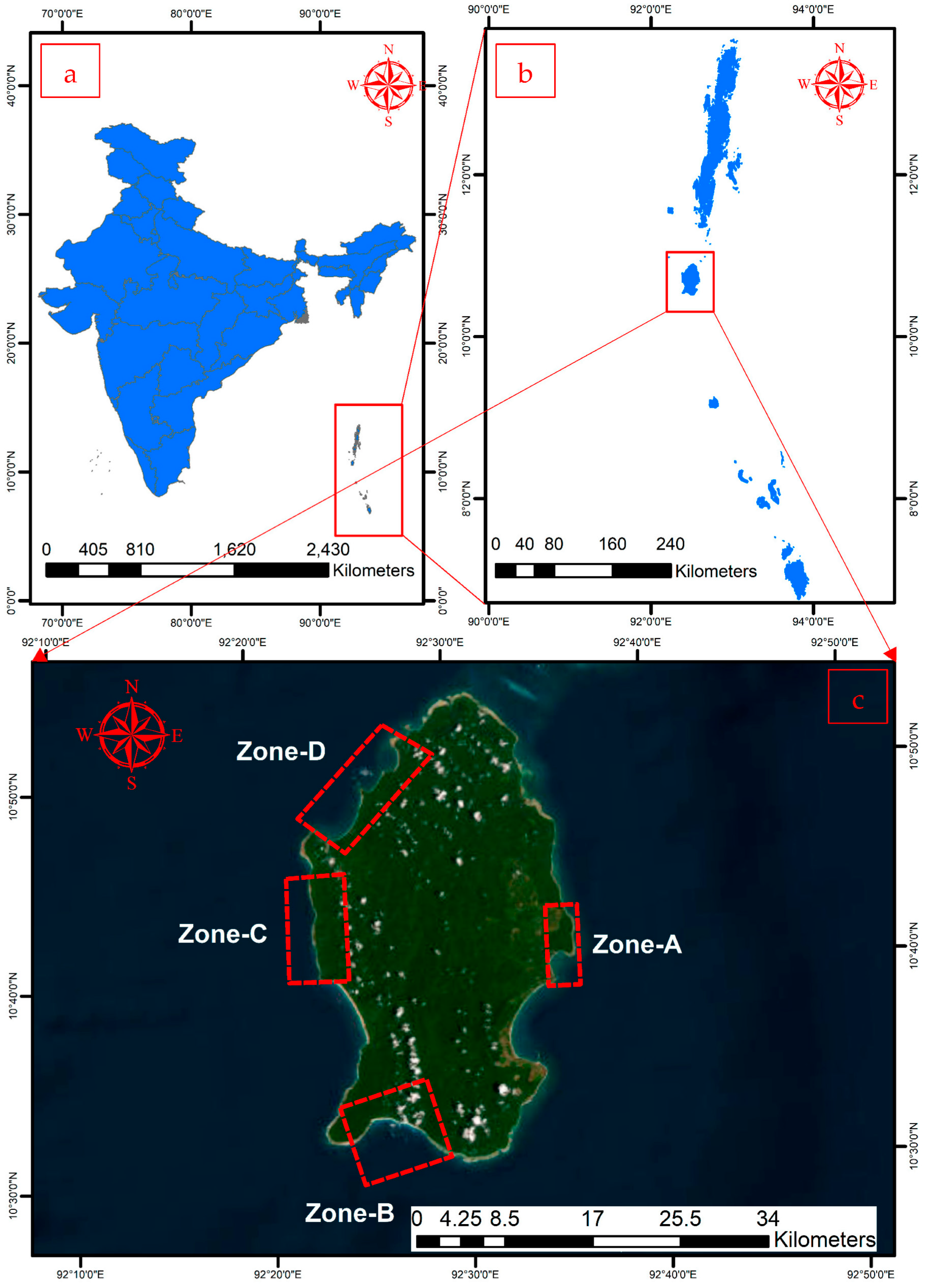

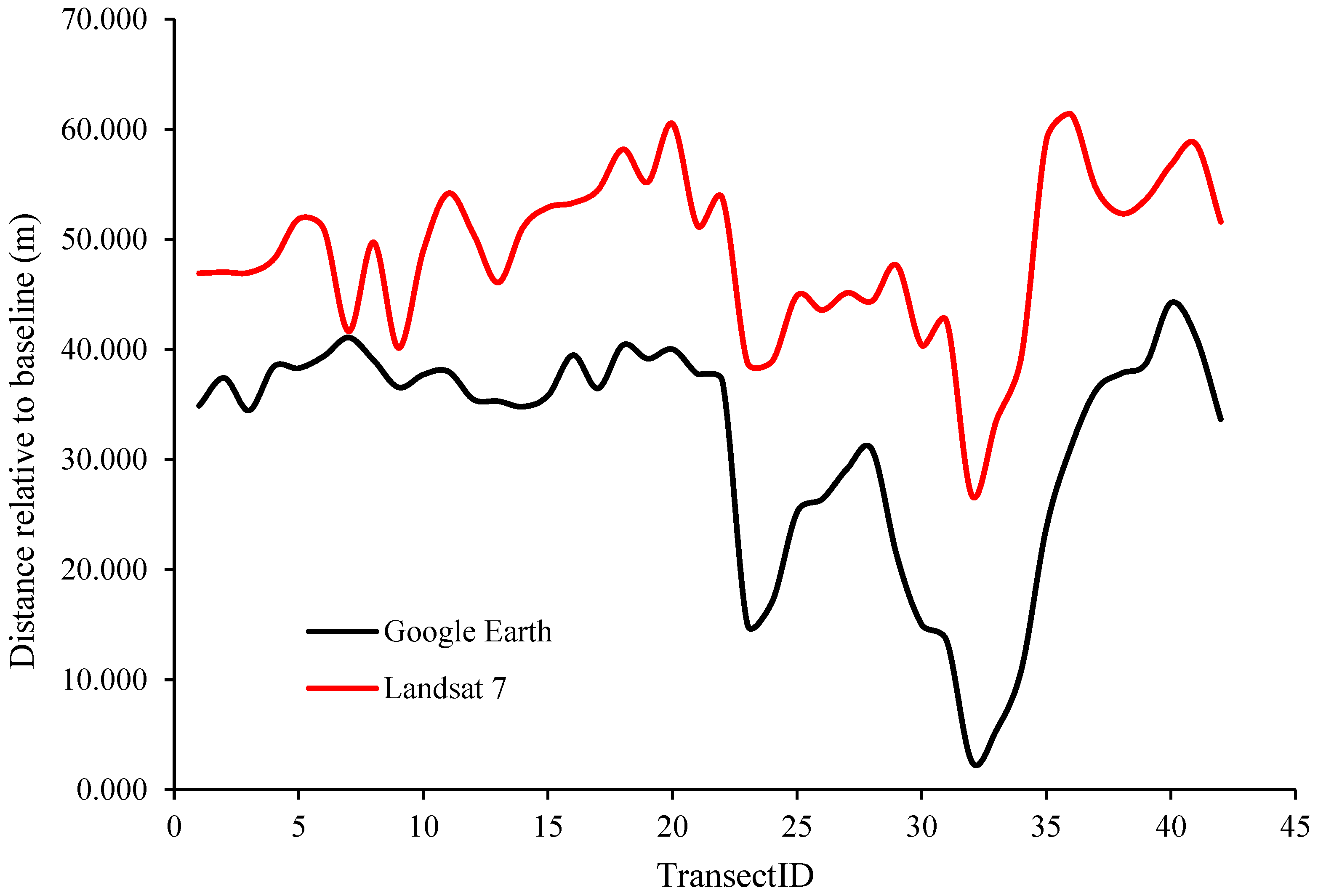

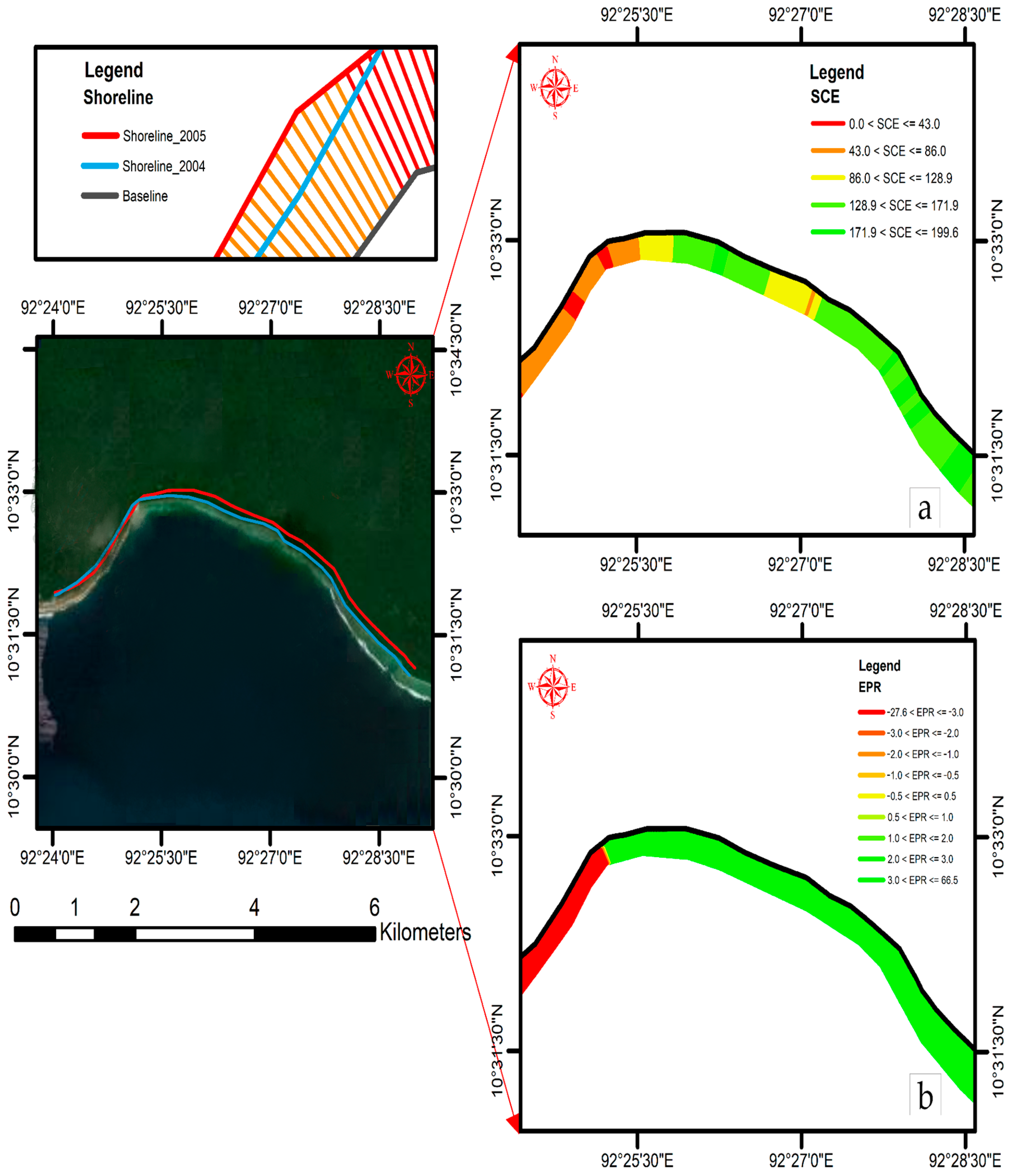
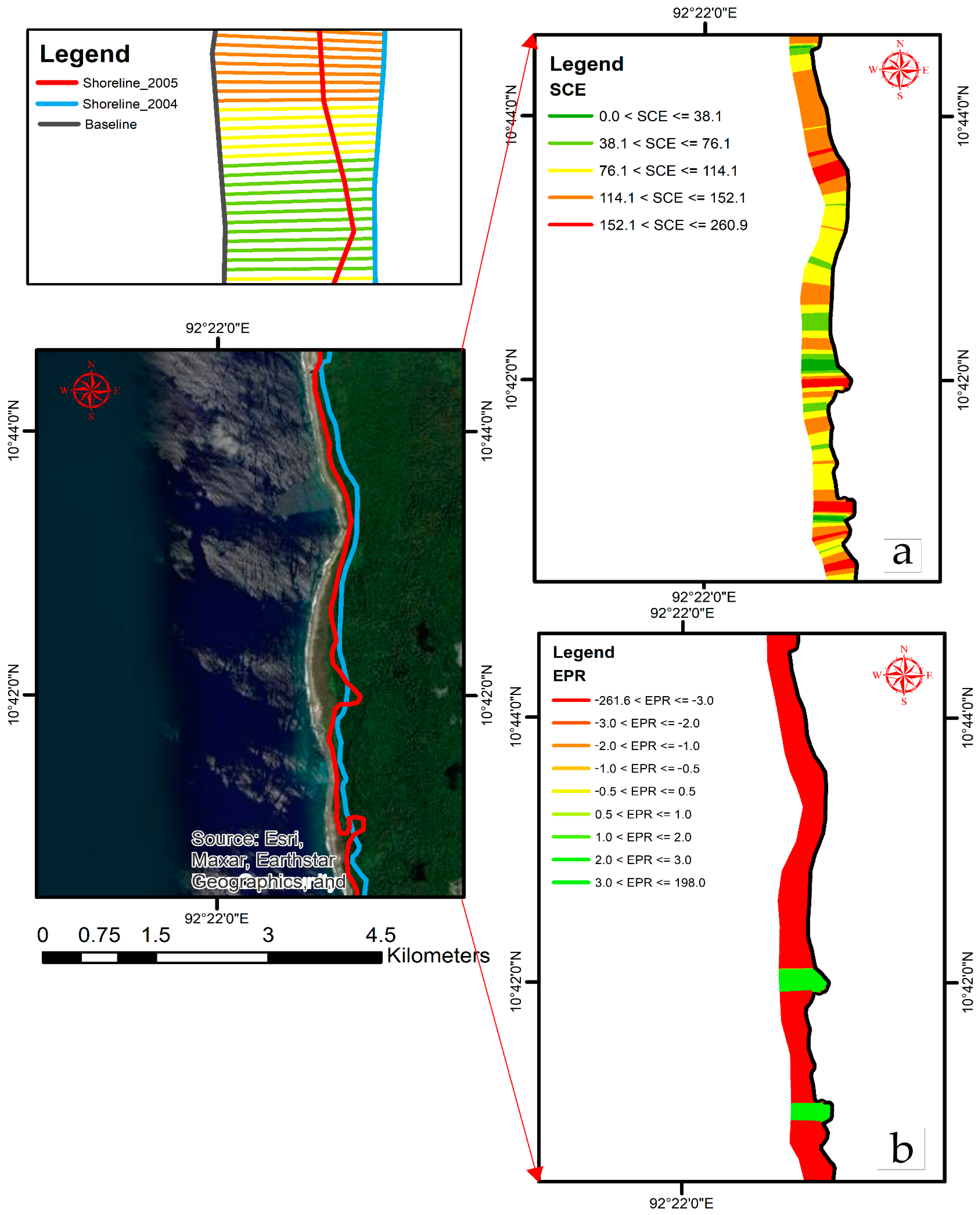
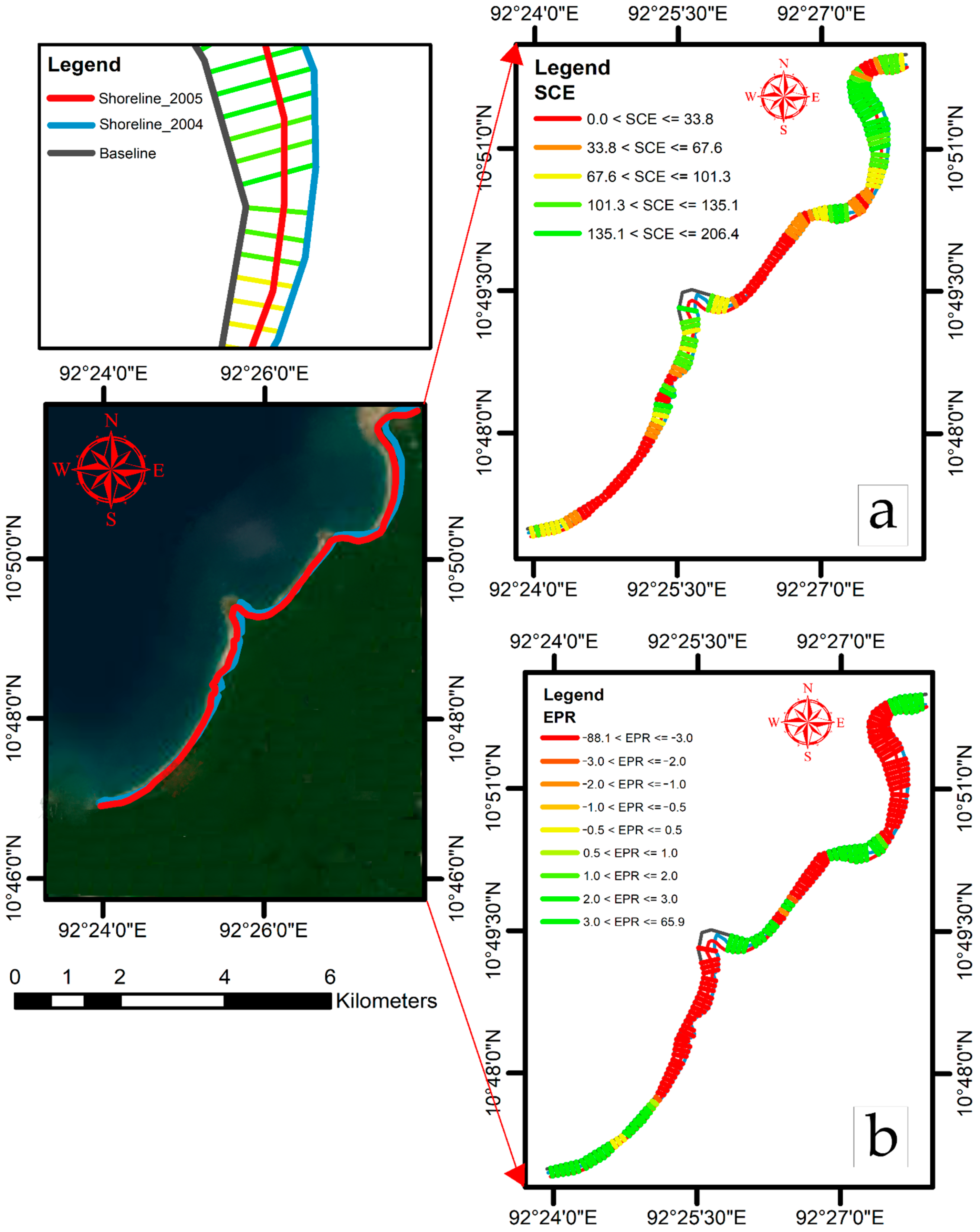
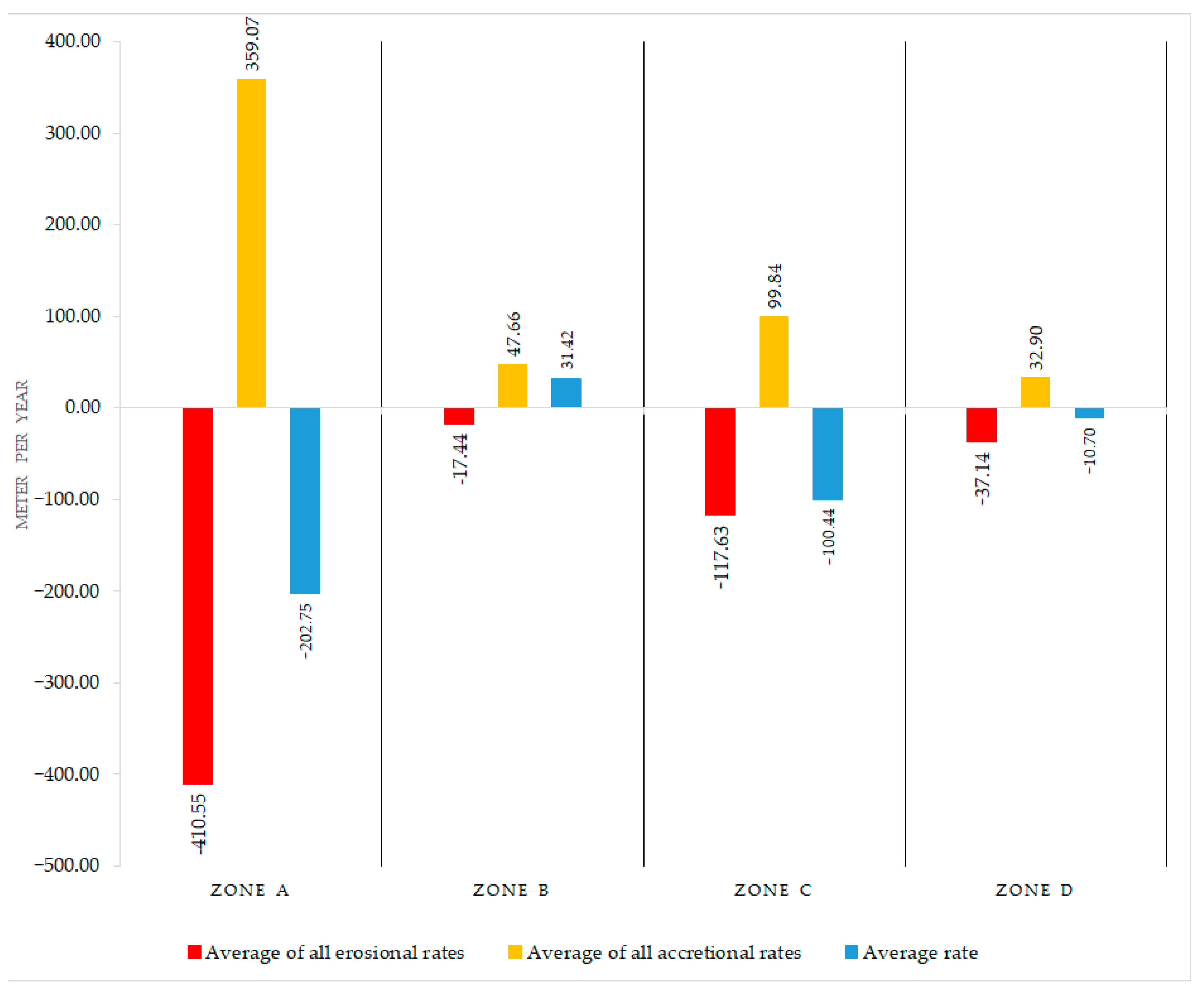




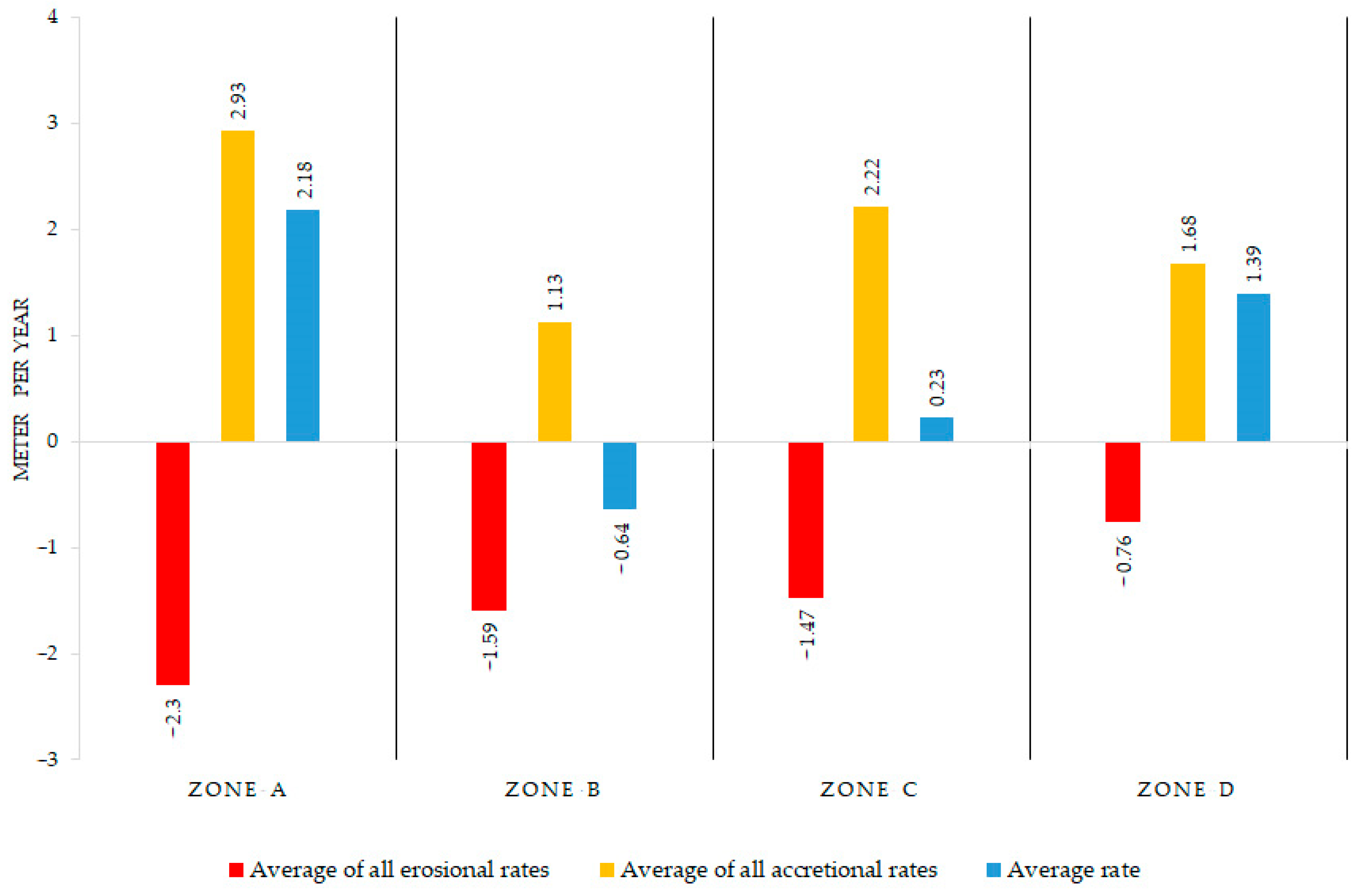
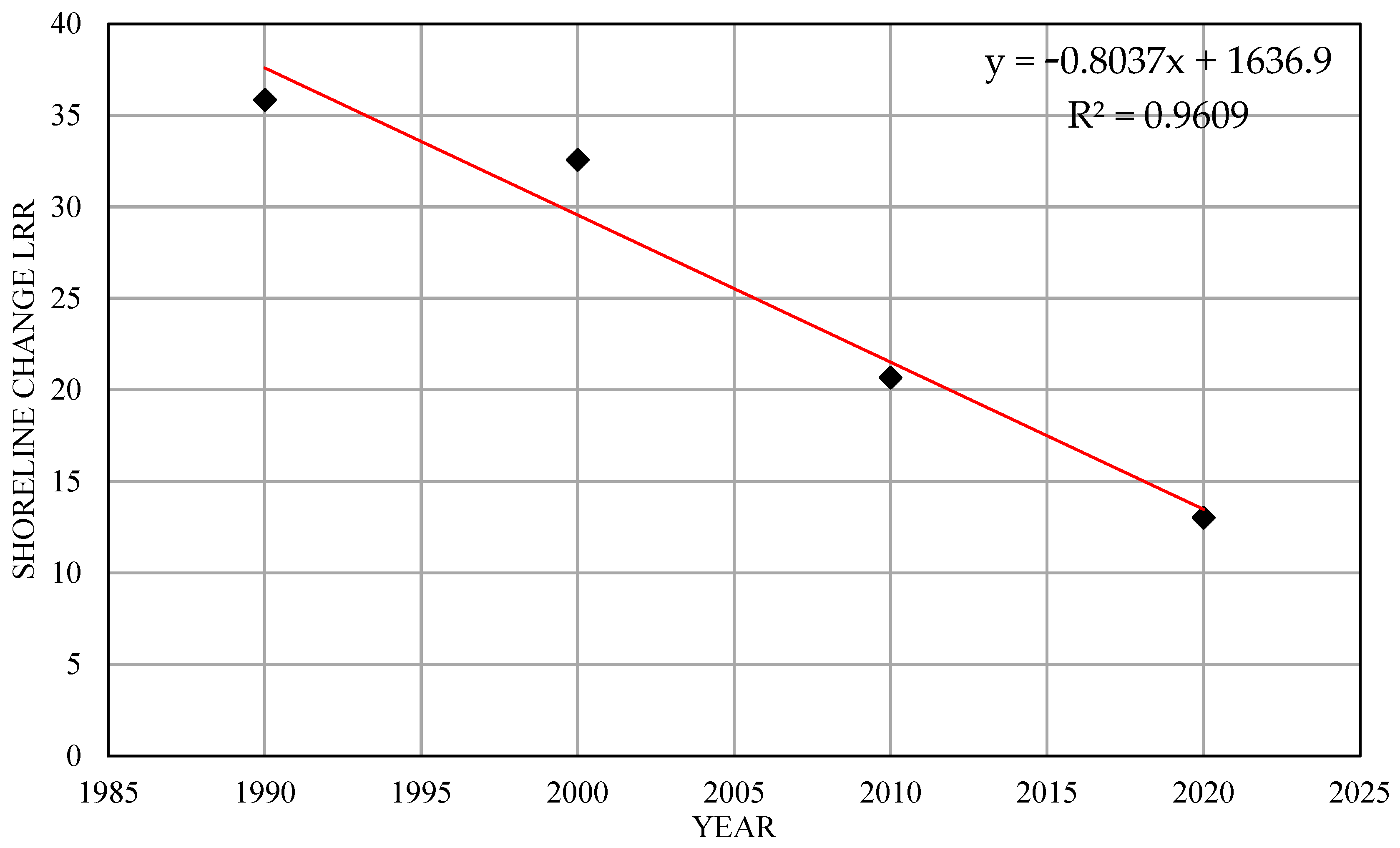
| Shoreline Change Envelope | Zone A | Zone B | Zone C | Zone D |
|---|---|---|---|---|
| Number of transects (overall) | 200 | 537 | 544 | 129 |
| Average distance (m) | 108.86 | 120.36 | 115.91 | 74.75 |
| Maximum distance (m) | 236.61 | 199.51 | 260.88 | 206.33 |
| Transect ID (maximum distance, m) | 164 | 15 | 514 | 13 |
| Minimum distance (m) | 0.48 | 0.02 | 1.98 | 0.01 |
| Transect ID (minimum distance, m) | 138 | 390 | 292 | 125 |
| End Point Rate | Zone A | Zone B | Zone C | Zone D |
|---|---|---|---|---|
| Number of transects (overall) | 200 | 537 | 544 | 129 |
| Avg. rate (m/year) | −202.75 | 31.42 | −100.44 | −10.7 |
| Number of erosional transects | 146 | 134 | 501 | 74 |
| % of all transects that are erosional | 73% | 24.95% | 92.10% | 57.36% |
| Greatest value of erosion (m) | −862.11 | −27.51 | −261.59 | −88.07 |
| Transect ID (maximum value, erosion) | 164 | 478 | 514 | 13 |
| All erosional rates (m/year) (average) | −410.55 | −17.44 | −117.63 | −37.14 |
| Number of accretional transects | 54 | 403 | 43 | 55 |
| % of all transects that are accretional | 27% | 75.05% | 7.90% | 42.64% |
| % of transects with statistically significant accretion | 27% | 74.86% | 7.90% | 39.53% |
| Greatest value of accretion (m) | 686.53 | 66.5 | 197.94 | 65.89 |
| Transect ID (maximum value, accretion) | 115 | 15 | 387 | 42 |
| All accretional rates (m/year) (average) | 359.07 | 47.66 | 99.84 | 32.9 |
| Shoreline Change Envelope | Zone A | Zone B | Zone C | Zone D |
|---|---|---|---|---|
| Number of transects (overall) | 215 | 217 | 224 | 259 |
| Average distance (m) | 96 | 81.39 | 105.06 | 57.43 |
| Maximum distance (m) | 258.31 | 175.33 | 259.49 | 176.07 |
| Transect ID (maximum distance, m) | 106 | 9 | 196 | 200 |
| Minimum distance (m) | 0.98 | 17.02 | 23.7 | 8.36 |
| Transect ID (minimum distance, m) | 175 | 131 | 71 | 225 |
| Net Shoreline Movement (m) | Zone A | Zone B | Zone C | Zone D |
|---|---|---|---|---|
| Number of transects (overall) | 215 | 217 | 224 | 259 |
| Average distance (m) | 71.12 | −20.82 | 7.41 | 45.54 |
| Number of transects (negative distance) | 38 | 141 | 121 | 31 |
| % of all transects (negative distance) | 17.67% | 64.98% | 54.02% | 11.97% |
| Maximum negative distance | 165.99 | −125.37 | −104.61 | −110.2 |
| Maximum negative distance, transect ID | 18 | 64 | 26 | 272 |
| Average of all negative distances | 42.59 | −51.95 | −48.13 | −24.8 |
| Number of transects (positive) | 177 | 76 | 103 | 228 |
| % of all transects (positive distance) | 82.33% | 35.02% | 45.98% | 88.03% |
| Maximum positive distance | 258.31 | 112.01 | 218.81 | 176.07 |
| Maximum positive distance, transect ID | 106 | 9 | 193 | 200 |
| Average of all positive distances | 95.54 | 36.93 | 72.65 | 55.11 |
| End Point Rate | Zone A | Zone B | Zone C | Zone D |
|---|---|---|---|---|
| Number of transects (overall) | 215 | 217 | 224 | 259 |
| Avg. rate (m) | 2.18 | −0.64 | 0.23 | 1.39 |
| Number of erosional transects | 38 | 141 | 121 | 31 |
| % of all transects that are erosional | 14.88% | 63.13% | 53.12% | 11.2% |
| Greatest value of erosion (m) | −5.08 | −3.83 | −3.2 | −3.37 |
| Transect ID (maximum value, erosion) | 18 | 64 | 26 | 272 |
| All erosional rates (meter/year) (average) | −2.3 | −1.59 | −1.47 | −0.76 |
| Number of accretional transects | 177 | 76 | 103 | 228 |
| % of all transects that are accretional | 82.33% | 35.02% | 45.98% | 88.03% |
| % of transects with statistically significant accretion | 79.53% | 34.1% | 44.64% | 87.64% |
| Greatest value of accretion (m) | 7.91 | 3.42 | 6.69 | 5.38 |
| Transect ID (maximum value, accretion) | 106 | 9 | 193 | 200 |
| All accretional rates (meter/year) (average) | 2.93 | 1.13 | 2.22 | 1.68 |
Disclaimer/Publisher’s Note: The statements, opinions and data contained in all publications are solely those of the individual author(s) and contributor(s) and not of MDPI and/or the editor(s). MDPI and/or the editor(s) disclaim responsibility for any injury to people or property resulting from any ideas, methods, instructions or products referred to in the content. |
© 2023 by the authors. Licensee MDPI, Basel, Switzerland. This article is an open access article distributed under the terms and conditions of the Creative Commons Attribution (CC BY) license (https://creativecommons.org/licenses/by/4.0/).
Share and Cite
Singh, S.; Singh, S.K.; Prajapat, D.K.; Pandey, V.; Kanga, S.; Kumar, P.; Meraj, G. Assessing the Impact of the 2004 Indian Ocean Tsunami on South Andaman’s Coastal Shoreline: A Geospatial Analysis of Erosion and Accretion Patterns. J. Mar. Sci. Eng. 2023, 11, 1134. https://doi.org/10.3390/jmse11061134
Singh S, Singh SK, Prajapat DK, Pandey V, Kanga S, Kumar P, Meraj G. Assessing the Impact of the 2004 Indian Ocean Tsunami on South Andaman’s Coastal Shoreline: A Geospatial Analysis of Erosion and Accretion Patterns. Journal of Marine Science and Engineering. 2023; 11(6):1134. https://doi.org/10.3390/jmse11061134
Chicago/Turabian StyleSingh, Saurabh, Suraj Kumar Singh, Deepak Kumar Prajapat, Vikas Pandey, Shruti Kanga, Pankaj Kumar, and Gowhar Meraj. 2023. "Assessing the Impact of the 2004 Indian Ocean Tsunami on South Andaman’s Coastal Shoreline: A Geospatial Analysis of Erosion and Accretion Patterns" Journal of Marine Science and Engineering 11, no. 6: 1134. https://doi.org/10.3390/jmse11061134











